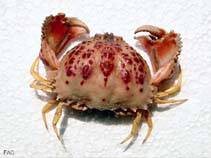Calappa granulata (Linnaeus, 1767)
Shamefaced crabWarning: DOMDocument::load(): SSL operation failed with code 1. OpenSSL Error messages: error:140770FC:SSL routines:SSL23_GET_SERVER_HELLO:unknown protocol in C:\Apache24\htdocs\includes\SpeciesSummary.lib.php on line 1236
Warning: DOMDocument::load(): Failed to enable crypto in C:\Apache24\htdocs\includes\SpeciesSummary.lib.php on line 1236
Warning: DOMDocument::load(https://sealifebase.nrm.se/webservice/AquaMaps/getAMap.php?genus=Calappa&species=granulata): failed to open stream: operation failed in C:\Apache24\htdocs\includes\SpeciesSummary.lib.php on line 1236
Warning: DOMDocument::load(): I/O warning : failed to load external entity "https://sealifebase.nrm.se/webservice/AquaMaps/getAMap.php?genus=Calappa&species=granulata" in C:\Apache24\htdocs\includes\SpeciesSummary.lib.php on line 1236
Classification / Names Common names | Synonyms | CoL | ITIS | WoRMS
Malacostraca | Decapoda | Calappidae
Environment: milieu / climate zone / depth range / distribution range Ecology
Benthic; depth range 10 - 700 m (Ref. 106272), usually 30 - 150 m (Ref. 435). Subtropical; 46°N - 14°N, 32°W - 36°E
Distribution Countries | FAO areas | Ecosystems | Occurrences | Introductions
Eastern Atlantic and the Mediterranean: from the Sahara to the coast of Portugal and Israel in the Mediterranean.
Length at first maturity / Size / Weight / Age
Maturity: Lm ? range ? - ? cm Max length : 10.0 cm CL male/unsexed; (Ref. 84401)
Carapace width: 9.2 cm (Ref. 435). Sublittoral, typically burrows in inshore soft bottoms (Ref. 106272). Also burrows in sand at depths of 13 to 400 m, common at depths of 30 to 150 m (Ref. 435). Found on a variety of bottoms -- sandy, shell grit, hard rocks and coral (Ref. 106272). Reported on upper to middle slope as well as in a seamount (Ref.106167). Infaunal feeder preying on bivalves and foraminiferans (Ref. 52384).
Life cycle and mating behavior Maturity | Reproduction | Spawning | Eggs | Fecundity | Larvae
Members of the order Decapoda are mostly gonochoric. Mating behavior: Precopulatory courtship ritual is common (through olfactory and tactile cues); usually indirect sperm transfer.
Main reference
References | Coordinator | Collaborators
Fischer, W., G. Bianchi and W.B. Scott (eds.). 1981. (Ref. 435)
IUCN Red List Status (Ref. 130435)
CITES status (Ref. 108899)
Not Evaluated
CMS (Ref. 116361)
Not Evaluated
Threat to humans
Human uses
Fisheries: commercial
| FishSource |
Tools
More information
Internet sources
BHL | BOLD Systems | CISTI | DiscoverLife | FAO(Publication : search) | Fishipedia | GenBank (genome, nucleotide) | GloBI | Gomexsi | Google Books | Google Scholar | Google | PubMed | Tree of Life | Wikipedia (Go, Search) | Zoological Record
Estimates based on models
Preferred temperature
(Ref. 115969): 13.3 - 19.2, mean 15.4 (based on 212 cells).
Resilience
(Ref. 69278):
High, minimum population doubling time less than 15 months (K=0.31).
Price category
(Ref. 80766):
Unknown.



